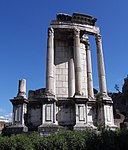Santi Cosma e Damiano

The basilica of Santi Cosma e Damiano is a titular church in Rome, Italy. The lower portion of the building is accessible through the Roman Forum and incorporates original Roman buildings, but the entrance to the upper level is outside the Forum. The circular building located at the entrance of the Forum, which now houses a small archeological exhibit, was built in the early 4th century as a Roman temple. It is thought to have been dedicated to Valerius Romulus, deified son of the emperor Maxentius. The main building was perhaps the library of an imperial forum. It became a church in 527 and contains important but much restored early Christian art, especially in its mosaics. Today it is one of the ancient churches called tituli, of which cardinals are patrons as cardinal-deacons. Since 28 November 2020 the title has been held by Cardinal Mario Grech. The basilica, devoted to the two Arabian Christian brothers, doctors, martyrs and saints Cosmas and Damian, is located in the Forum of Vespasian, also known as the Forum of Peace.
Excerpt from the Wikipedia article Santi Cosma e Damiano (License: CC BY-SA 3.0, Authors, Images).Santi Cosma e Damiano
Via in Miranda, Rome Municipio Roma I
Geographical coordinates (GPS) Address External links Nearby Places Show on map
Geographical coordinates (GPS)
| Latitude | Longitude |
|---|---|
| N 41.8920625 ° | E 12.4874308 ° |
Address
Santi Cosma e Damiano
Via in Miranda
00184 Rome, Municipio Roma I
Lazio, Italy
Open on Google Maps









